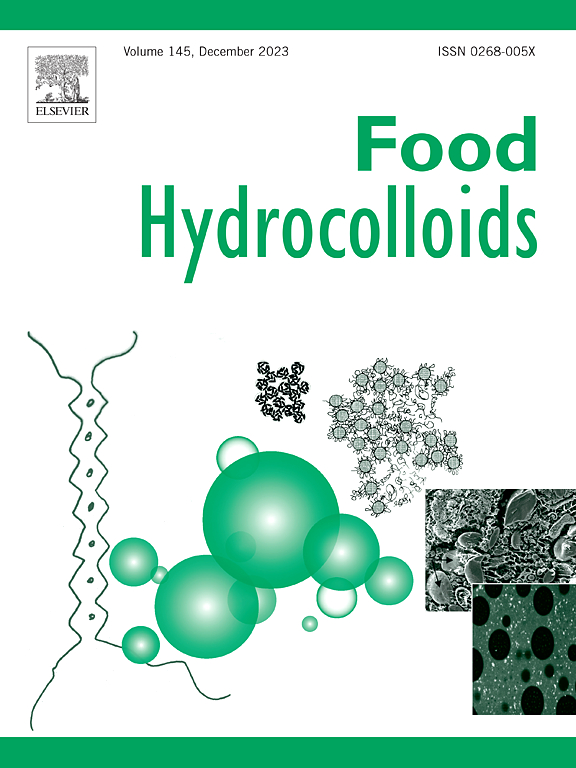Hydrophobic plant protein-polysaccharide composite enables high moisture extrusion of anisotropic textures at low temperature
IF 11
1区 农林科学
Q1 CHEMISTRY, APPLIED
引用次数: 0
Abstract
The prevalent process of producing anisotropic high-moisture meat alternatives is to denature globular plant proteins at high temperatures and then deform the melt in the cooling die. In this study, we introduce an alternative approach that enables extrusion at a maximum barrel temperature of 80 °C: bond strengthening→contraction→plasticization→deformation. A formulation of zein and patatin-rich potato protein (75:25), pea starch, and high-acyl gellan gum was developed and extruded using a twin-screw setup with a cooling die, where barrel sections were maintained at 40–80 °C. The resulting composite material exhibited high anisotropy (anisotropic index up to 1.5), with gellan gum concentration significantly influencing both visual and measurable anisotropy. Molecular dynamics simulations revealed that heating promotes the elongation of zein molecules and their strong non-covalent interactions with HA-gellan gum and patatin via hydrogen bonding and electrostatic forces, leading to integration into a cohesive protein network. In contrast, starch remains predominantly at the surface, contributing to the smoothing and cohesive properties of the extrudate, highlighting the influence of ingredient interplay on extrudability and textural attributes. This novel approach demonstrates the feasibility of creating meat analogs with improved texture and reduced energy demands at up to 50 % lower temperatures, opening avenues for the inclusion of heat-sensitive ingredients.

疏水植物蛋白-多糖复合材料可以在低温下实现各向异性织构的高水分挤压
生产各向异性高水分肉类替代品的普遍工艺是在高温下使球形植物蛋白变性,然后在冷却模具中使熔体变形。在这项研究中,我们介绍了一种替代方法,使挤压在最高桶温80°C:粘结强化→收缩→塑化→变形。一种富含玉米蛋白和马铃薯蛋白(75:25)、豌豆淀粉和高酰基结冷胶的配方被开发出来,并使用带有冷却模具的双螺杆装置进行挤压,其中桶状部分保持在40-80°C。所得复合材料表现出较高的各向异性(各向异性指数高达1.5),结冷胶浓度对其视觉和可测量的各向异性均有显著影响。分子动力学模拟表明,加热促进了玉米蛋白分子的伸长,并通过氢键和静电力促进了玉米蛋白分子与ha -结冷胶和patatin的强非共价相互作用,从而整合成一个有凝聚力的蛋白质网络。相比之下,淀粉主要停留在表面,有助于挤出物的平滑和粘合性能,突出了成分相互作用对挤出性和结构属性的影响。这种新颖的方法证明了在温度降低50%的情况下制造具有改善质地和减少能量需求的肉类类似物的可行性,为热敏性成分的加入开辟了道路。
本文章由计算机程序翻译,如有差异,请以英文原文为准。
求助全文
约1分钟内获得全文
求助全文
来源期刊

Food Hydrocolloids
工程技术-食品科技
CiteScore
19.90
自引率
14.00%
发文量
871
审稿时长
37 days
期刊介绍:
Food Hydrocolloids publishes original and innovative research focused on the characterization, functional properties, and applications of hydrocolloid materials used in food products. These hydrocolloids, defined as polysaccharides and proteins of commercial importance, are added to control aspects such as texture, stability, rheology, and sensory properties. The research's primary emphasis should be on the hydrocolloids themselves, with thorough descriptions of their source, nature, and physicochemical characteristics. Manuscripts are expected to clearly outline specific aims and objectives, include a fundamental discussion of research findings at the molecular level, and address the significance of the results. Studies on hydrocolloids in complex formulations should concentrate on their overall properties and mechanisms of action, while simple formulation development studies may not be considered for publication.
The main areas of interest are:
-Chemical and physicochemical characterisation
Thermal properties including glass transitions and conformational changes-
Rheological properties including viscosity, viscoelastic properties and gelation behaviour-
The influence on organoleptic properties-
Interfacial properties including stabilisation of dispersions, emulsions and foams-
Film forming properties with application to edible films and active packaging-
Encapsulation and controlled release of active compounds-
The influence on health including their role as dietary fibre-
Manipulation of hydrocolloid structure and functionality through chemical, biochemical and physical processes-
New hydrocolloids and hydrocolloid sources of commercial potential.
The Journal also publishes Review articles that provide an overview of the latest developments in topics of specific interest to researchers in this field of activity.
 求助内容:
求助内容: 应助结果提醒方式:
应助结果提醒方式:


